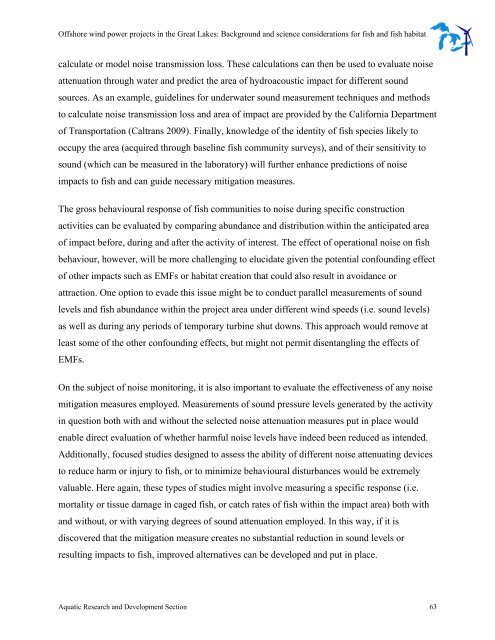Offshore Wind Power Projects in the Great Lakes - Ministry of ...
Offshore Wind Power Projects in the Great Lakes - Ministry of ...
Offshore Wind Power Projects in the Great Lakes - Ministry of ...
Create successful ePaper yourself
Turn your PDF publications into a flip-book with our unique Google optimized e-Paper software.
<strong>Offshore</strong> w<strong>in</strong>d power projects <strong>in</strong> <strong>the</strong> <strong>Great</strong> <strong>Lakes</strong>: Background and science considerations for fish and fish habitat<br />
calculate or model noise transmission loss. These calculations can <strong>the</strong>n be used to evaluate noise<br />
attenuation through water and predict <strong>the</strong> area <strong>of</strong> hydroacoustic impact for different sound<br />
sources. As an example, guidel<strong>in</strong>es for underwater sound measurement techniques and methods<br />
to calculate noise transmission loss and area <strong>of</strong> impact are provided by <strong>the</strong> California Department<br />
<strong>of</strong> Transportation (Caltrans 2009). F<strong>in</strong>ally, knowledge <strong>of</strong> <strong>the</strong> identity <strong>of</strong> fish species likely to<br />
occupy <strong>the</strong> area (acquired through basel<strong>in</strong>e fish community surveys), and <strong>of</strong> <strong>the</strong>ir sensitivity to<br />
sound (which can be measured <strong>in</strong> <strong>the</strong> laboratory) will fur<strong>the</strong>r enhance predictions <strong>of</strong> noise<br />
impacts to fish and can guide necessary mitigation measures.<br />
The gross behavioural response <strong>of</strong> fish communities to noise dur<strong>in</strong>g specific construction<br />
activities can be evaluated by compar<strong>in</strong>g abundance and distribution with<strong>in</strong> <strong>the</strong> anticipated area<br />
<strong>of</strong> impact before, dur<strong>in</strong>g and after <strong>the</strong> activity <strong>of</strong> <strong>in</strong>terest. The effect <strong>of</strong> operational noise on fish<br />
behaviour, however, will be more challeng<strong>in</strong>g to elucidate given <strong>the</strong> potential confound<strong>in</strong>g effect<br />
<strong>of</strong> o<strong>the</strong>r impacts such as EMFs or habitat creation that could also result <strong>in</strong> avoidance or<br />
attraction. One option to evade this issue might be to conduct parallel measurements <strong>of</strong> sound<br />
levels and fish abundance with<strong>in</strong> <strong>the</strong> project area under different w<strong>in</strong>d speeds (i.e. sound levels)<br />
as well as dur<strong>in</strong>g any periods <strong>of</strong> temporary turb<strong>in</strong>e shut downs. This approach would remove at<br />
least some <strong>of</strong> <strong>the</strong> o<strong>the</strong>r confound<strong>in</strong>g effects, but might not permit disentangl<strong>in</strong>g <strong>the</strong> effects <strong>of</strong><br />
EMFs.<br />
On <strong>the</strong> subject <strong>of</strong> noise monitor<strong>in</strong>g, it is also important to evaluate <strong>the</strong> effectiveness <strong>of</strong> any noise<br />
mitigation measures employed. Measurements <strong>of</strong> sound pressure levels generated by <strong>the</strong> activity<br />
<strong>in</strong> question both with and without <strong>the</strong> selected noise attenuation measures put <strong>in</strong> place would<br />
enable direct evaluation <strong>of</strong> whe<strong>the</strong>r harmful noise levels have <strong>in</strong>deed been reduced as <strong>in</strong>tended.<br />
Additionally, focused studies designed to assess <strong>the</strong> ability <strong>of</strong> different noise attenuat<strong>in</strong>g devices<br />
to reduce harm or <strong>in</strong>jury to fish, or to m<strong>in</strong>imize behavioural disturbances would be extremely<br />
valuable. Here aga<strong>in</strong>, <strong>the</strong>se types <strong>of</strong> studies might <strong>in</strong>volve measur<strong>in</strong>g a specific response (i.e.<br />
mortality or tissue damage <strong>in</strong> caged fish, or catch rates <strong>of</strong> fish with<strong>in</strong> <strong>the</strong> impact area) both with<br />
and without, or with vary<strong>in</strong>g degrees <strong>of</strong> sound attenuation employed. In this way, if it is<br />
discovered that <strong>the</strong> mitigation measure creates no substantial reduction <strong>in</strong> sound levels or<br />
result<strong>in</strong>g impacts to fish, improved alternatives can be developed and put <strong>in</strong> place.<br />
Aquatic Research and Development Section 63
















